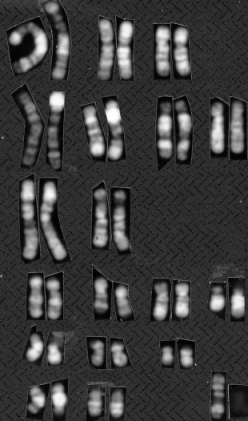Cattle chromosomes, 2n=60,XY. Stain method
BrdU incorporation - Acridine Orange

Swine chromosomes, 2n=38,XX.

. .

Metaphase chromosomes spread by means of the air drying method, make all the chromosomes of a cell stay in the same plane on the slide. By photo the cells that do not overlap are selected, so that the individual chromosomes can be identified. Additionally, the chromosomes have to be as long as possible. See for instance the blue fox metaphase chromosomes stained with Giemsa in section 10.3, which are fairly short.
The chromosomes can be set up pairwise, when individual pairs can be identified. A photo is taken and the chromosomes are cut out and
arranged as shown in Figure 10.1.
They are arranged according to internationally acknowledged enumeration systems. The
enumaration systems are mostly ordered according to size and/or the
position of the centromere. In each chromosome pair one of the chromosomes comes
from the father and the other from the mother, these are called homologous
chromosomes. Each species of domestic animals has specific chromosomes, regarding
the number as well as the form. The number of chromosomes in mink is 30 and in dogs
78. Normally, animals with acrocentric chromosomes have the highest number of
chromosomes. Therefore in the dog all, but the sex-chromosomes, are acrocentric.
In the mink all the chromosomes are metacentric except for one pair.
Examples of chromosomes from three species are shown in Figure 10.1.
| Figure 10.1. Cattle chromosomes, 2n=60,XY. Stain method BrdU incorporation - Acridine Orange  Swine chromosomes, 2n=38,XX.  |
. . Cat chromosomes, 2n=38,XX. . .  |
The Bovidae
Cattle chromosomes and chromosomes from sheep and goat are quite similar. Like
cattle goat has 60 chromosomes, which are all nearly identical
with those in the cattle, except for the sex-chromosomes X and Y. The X-chromosome in the goat is acrocentric (the cattle's X is sub-metacentric) and the
Y-chromosome is much smaller than the cattle's. In sheep the same differences in
the sex-chromosomes are found, but in addition there are three centromere fusions.
The chromosomes, 1/3, 2/8 and 5/11, are fused in comparison with those
in cattle and goat. Therefore, the sheep has only 54 chromosomes.
Regular fertile offspring can occur from the mating of a female goat and a male
sheep. If the parents' sex is reversely combined the foetuses will die before term. The
duration of the gestation period is almost the same for sheep and goat, around 148 days.
The Canidae
The two fox species found in Danish fur farms, the red and the blue fox, have
respectively 34 and 50 chromosomes. The red fox has only metacentric
chromosomes and one to five additional micro chromosomes. The significance of the micro chromosomes is
unknown. The blue fox has two pairs of acrocentric chromosomes, the rest are metacentric.
After mating the two fox species non-fertile offspring occur in regular amounts. The
duration of the gestation period is nearly identical for the two
species, 58 days. A cross of the two species has at times been popular in the fur production.
Another canine species, the dog, has 78 chromosomes, which all are acrocentric, as
mentioned earlier. So, compared to the Bovidae, the evolution of the chromosomes
of the
Canidae has been very fast. On the DNA level, in contrast, the Canidae species are very
similar, see table in section 2.5, which deals with similarities of microsatellites in the three species.
Mink have 30 chromosomes, only, see next section or here. The mink chromosomes are somewhat similar to cat chromosomes, but are very different from those in foxes and dogs.
The Equidae
The horse has 64 chromosomes and the ass 62. The chromosomes in these two
species are quite different. But non-fertile
offspring can be produced from mating a horse mare and an ass stallion. This cross is called
a mule, a very strong and enduring animal.
The Gallus
The chromosomes of hen are similar to those of other birds and reptiles. Six of
the chromosome pairs are similar to those found in mammals, while the remaining are micro-chromosomes, 2n= 78. The sex-chromosomes are
some of the largest ones. They are called ZZ in the cock and ZW in the hen. So
among birds the female is the hetero gametic sex, which determine the sex of the
offspring. Bird chromosomes can be seen here.
Mapping of Chromosomes
When working with chromosome mapping, the idea is to place a specific gene in a specific place on a chromosome. Therefore, for each species a specific standard with enumeration of each chromosome is made. For this nomenclature it has been decided that the shortest arm of the chromosome should be called the p-arm and the longest the q-arm. When the chromosomes are presented, the q-arm is always turned downwards. The enumaration of the bands on the arms begins at the centromere and continues towards the telomeres (the end of the chromosomes).